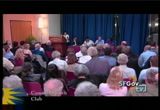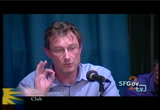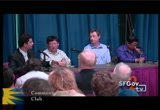tv [untitled] April 16, 2013 4:25pm-4:55pm PDT
4:25 pm
networking products. he has been -- he has a degree in management from stanford, an ms from the university of central florida, and a degree in electrical engineering from the indian institute technology, bombay. he has authored numerous publications and has over 50 u.s. patents. >> thank you for organizing this panel discussion, and thank you, everybody, for graciously being here today. it is my great honor to introduce an incredibly distinguished panel of industrial luminaries. let me start with timothy, simon, and jeanette. tim is a professor at the stanford business school where he teaches a very popular class
4:26 pm
on this service via in fact, i have taken your class, and you bring in some incredible speakers and make it very entertaining. jim also has a distinguished career in the private sector. he was the president of oracle's on demand service, which by some records was the first online on demand service. cloud computing has a lot of fathers, but tim is often called the grandfather of cloud computing because of that endeavor. but tim is also an investor in a cloud computing companies, and author of some very exciting cloud computing books. thank you for being here. next, we have simon crosby. he is an entrepreneur, who has just launched his latest company, and he might tell us a little bit about it. before that, almost just about a month ago, he was the cto of
4:27 pm
citrix systems. he got there by selling his last company to them. that company has developed some of the key virtualization technologies, which enable the cloud. he made a big contribution. thank you for that. last but definitely not least, we have jeanette tomlinson, the cto of our very own, dear city of santa francisco -- gina, and sen. she has had a very daunting task of taking the legacy infrastructure of the city and moving that to a professional data center. but also, setting up a virtual private cloud and making a foray into the public cloud. she offers a unique perspective
4:28 pm
as a large government user on cloud computing. she was also the cio of the san francisco municipal transport station at 40, and she was also managing clorox's data centers previously. thank you for being here. with so much brainpower and prospective in this room, i will actually ask each of our panelists to take four or five minutes and give us a landscape of where you think of computing is today and where you see it going. am standing here with these microphones makes you feel like what rupert murdoch must have felt like this morning. i have no direct knowledge of the cloud. [laughter] let me make a small correction since my academic colleagues -- you're so sensitive to this. i am lecturer at stanford university, not a professor. that is another level of this conversation teary let me extend the conversation a little bit.
4:29 pm
one of the things that it was after i left or go, i taught for many years at stanford and talk, as i told the kids, real stuff. i started a class on cloud computing. three years ago, i started a class at the university in beijing as well on this subject because i feel it is really important. we are in my opinion in the second year of a 20-year cycle that is no different than the client server cycle that happened last time around, and i think education is an important component of this. so i'm going to take my four or five minutes to educate you guys a little bit on what is this thing we call cloud computing. i'm going to try uses much plain english as i can, leave all the technical buzzwords aside, and try to eliminate -- illuminate for you what is happening. fundamentally, is an economic thing that is happening, and that is what has always driven technologies economics. i will get to that in a minute. i do a lot of public speaking.
4:30 pm
i was counting today because i had to do something this morning. over the past six months, i have talked to 5000 people about cloud computing. what i've tried to do with them and what i've tried to do with you is tried to explain cloud computing in a way you could explain to your facebook friends. [laughter] let me start with we all use cloud computing. we all use consumer application clout services. twitter, facebook, ebay, google, amazon, etc., you are using consumer application clout services. just so we realize how far we have transition, i was with a stanford did about two months ago, and i'm giving her the lecture on what is cloud computing, and i start that way. i say once upon a time, consumer applications used to get installed on your pc and update and all that, as she looks at me and said, "i've heard of this thing. isn't it called a floppy disk?"
4:31 pm
[laughter] what many of you guys probably do not know is on the business application front, this has similarly happen in a very different way. nearly every business application -- when i talk about business applications, and talking about financial customer relationships systems, purchasing, hr, web analytics, all the software business is used to automate their businesses. what you may not know is in the past 10 years, every business application software company which has gone public has been delivered as a cloud service. nobody does it in the new world the old way anymore. is all delivered as a cloud service. this ranges from -- many of you are in san francisco. you know who salesforce is. they have been a huge leader in this. even in the whole bay area. you have netsuite. as i said, nearly everyone. i will give you one example,
4:32 pm
which you all are probably familiar with, which you will think is an odd example, which is opentable. i'm guessing because san francisco is ground zero, right? on the one hand, you see an open table as a consumer application cloud service, right? you go on, reserve restaurant space, right? it is free. the other side is a business application. they are selling to restaurants. software to help them increase the number of people. that has happened really within the past 10 years. as i said, every application. increasingly, what has happened is highly specialized applications. i will give you one example of that. dealer track. they actually do loan origination software for automotive loans. today, basically 80% of all the
4:33 pm
loans in the united states are processed through their software. we will see much more of this. we want to talk about not as public companies, tons of this. all of these guys uses the original cloud service. a lot of people have asked me why we call it a cloud. what does this come from? it is pretty simple. in the old days of client-server computing -- some of us were around them -- we would draw a picture of a pc, a picture of a unix server, and then a picture of a little clout in between. mostly because none of us understood how networks work. for the old folks in the room, you may remember certain words. this is all communication technology developed for corporations to build their own networks. that sounds like crazy talk today, right? nobody does that anymore. everybody is using ip, mpls-
4:34 pm
based networks. that is the network cloud. the network guys realize that in order to build a network service, they had to put these things called switches and routers in a room that had high quality power, guard dogs out front, and not located on a fault line, right? since the advent of data centers. many companies enter into the market. it is not a trivial market to enter. the cost of building these things, by the way, is $1,000 per square foot, which is expensive even by california standards. cost of power dominates this. this has been an interesting space for a variety of reasons, and i will leave it there, but datacenter clouds services is the other component being delivered, right? finally, i will introduce you to last things. first is something that have been very innovative about five years ago when jeff bezos said
4:35 pm
he would deliver computers and storage as a cloud service. everybody thought that he was crazy. like why the hell are you doing this? oh, can i say that? why are you doing this, right? they have not released public numbers, but their computers and storage class of service at this point in time is right on -- widely believed to be added billion dollars run rate in five years, which is meteoric growth in this business, which is what basically everybody and their brother has entered into this marketplace. from the little guys, people you have probably never heard of all the way to the big boys in the room like microsoft, etc. we have not seen the end of this story. by the way, for applications, they are very unique to some specific need. when you talk about computers and storage, everyone of us uses it.
4:36 pm
compute and storage clouds services. the last two things that are happening -- and this is very new right now -- is software development clouds services. for those of you in the room who aspire to or will have built software, building software in a world where the amount of time from the time i come up with the idea to the time is running in production is measured in days or weeks and not years, right? the whole development infrastructure completely different, right? and how i go about doing that. this is a very nascent space at this stage. force.com has been doing stuff here. lots and lots of stuff happening here. by the way, this is going to ignite the whole thing. that is what happened last time. the guy who ignited client server was a developer peter last thing -- operations management. you may never have managed -- she can say this.
4:37 pm
you manage applications, you have to manage the security, availability, performance, changes, problems in that software that you bought. you can choose to do that with manual labor, which is painful and very expensive, or you can start to use software to help you do that. that has been going on for years in operations management software. what is new happening now is all the software is being delivered as a cloud service. i could give you a very simple example. once upon a time, if you wanted to make sure you have no spam on your side, you've got spam filtering software, installed it on your pc, managed it here today, nobody does that. this space is enormous, and it is just -- it has just started up. across the board -- i will end by saying we -- as i said, we are in year two of a 20-year cycle. it is no different than what we saw with client-server.
4:38 pm
in fact, for the old people in the room, and i am one of them, i will tell you i have heard all the same things we say during that era. people would say you are never going to want to run on unix. it is not scalable. it is not reliable. you'd never want to what -- run on oracle. it is not secure, reliable. for the technical people in the room, was unix a technologically better system? was oracle better than db2 technologically? the answer i will tell you is no. what they were were economically better. the massive difference in the economics of this, which has driven every stage of computing here, and that is what is going to drive this forward. i will end by letting you -- if there's one thing i want you to walk away with, i am going to tell you a little story, and i'm going to pass it back. as i said, i teach a class in
4:39 pm
beijing, and the amazon boys are very nice to me. they gave me $3,000 worth of computers and storage, so i showed up in class and said, "you get $3,000 of computer and storage." turns out that buys you about 2 1/2 years of a server, you can pick northern california, virginia, ireland, right? most of the kids in the room are looking at me saying that it is kind of boring. they can get a server in beijing. what difference does it make year or $3,000 buys 10,000 computers for 30 minutes. nobody has ever been given 10,000 computers for 30 minutes for $3,000. it is in the question that they looked at me at that stage and went, "what would i do with that?" that is the seat of the next step.
4:40 pm
there are lots of examples already happening around us, but this is the magic. as soon as the smart kids out there start figuring out what you do, we ignite this thing with a rocket ship. this has nothing to do with total cost of ownership or any of that. it has to do with being able to do things we economically could never do before. i will conclude i see the floor. >> thank you, tim. simon. >> well, now you know all about how computing. [laughter] let me give you a slightly different angle. i think of the cloud as being roughly categorized into two worlds. there is the clout as envisaged and manifested within the enterprise, which includes the city of santa francisco. large organizations of people who have i.t. needs. then there is another kind of clout, which is the cloud that is in your pockets, which is most of what jim spoke to. everyone of us walked into our job every day with a cloud in our pocket, okay?
4:41 pm
that is the apps that sit on your smart device. you are driving cloud adoption far faster than enterprise i.t. can adopt anything. actually, most enterprise i.t. shops since 2003, if you are lucky. we are delighted with this experience, delighted to innovate upon, and that is where you see all this amazing innovation on top of new form factor devices like tablets and smartphones, and yet, the real world, which is the world in which we live -- absolutely sucks from a user experience. we are in this horrible position whereby we as consumers are driving this incredible rate of change for our enterprise employers, and while you might be quite happy to publish anything about yourself and your
4:42 pm
family on facebook and twitter and anything else he might choose to do it, the government is definitely not happy with you putting corporate staff or government stuff up there as well. so we as consumers are driving this phenomenal rate of change. the growth rate in the public cloud market to 60% or 70% just to the server count. certainly north of 100% per year in terms of bandwidth requirements for the public internet right now. so we are consuming things, and that is all fab here the problem is that we as humans in the rest of our lives actually deal with today's enterprise applications. none of them run on a cloud. they are subject to regulatory compliance. your desktop has nothing to do with the clout at all. the challenge is that cloud really is leading this enormous change on the enterprise i.t. environment. let's call a broadly the
4:43 pm
consumerization of i.t. the problem that brings is that while you're happily wandering into the enterprise every day with your klauer in your pocket, a whole bunch of that actually belongs to somebody else. it belongs to another interest. maybe multiple interests. so your personal consumption of cloud is quite literally a threat to your employer. let's be very clear. the very recent publicized attacks against rsa were the key seeds for the technology was stolen. the attacks on google. the attacks published just this week against u.s. defense interests. were initiated from users like you. ok? humans like you to click on a url, an attachment in e-mail, and let the bad guys in.
4:44 pm
for most of the enterprise world, the public cloud is nothing more than a menace. yet, we see it's clear benefits. we see its enormous cost advantages. we see all these wonderful things that tin told you about. so the challenge is to try and evolve what today is a process built around people. people and process and regulation that tries to keep us safe, tries to run our economy, and translate it into something that is more efficient, that takes advantage in evolution or revolution of technology, arguably, but does not hand out -- does not toss out the baby with the bath water. that is the challenge. whilst in a heavy user of a tablet device and everything else, i think that is kind of ho-hum. it is fabulous you can build a startup in your garage again, but the challenge is how do we adopt this technology in a world
4:45 pm
where the rate of adoption is governed not by anything to do with technology itself but by the rate at which humans can evolve their skill sets as they face new technologies. that is what enterprise i.t. is. i can tell you with -- that its -- i can tell you the confidence that is what enterprise i.t. is. we need to get newer people in. we need to upgrade the skills that. let me try and describe it. the only thing interesting in technology is an exponential curve. and it doubles, and whilst we in our human experience live in linear times with linear skill sets, thinking what to do tomorrow, by the time tomorrow comes, technology has moved the world ahead a whole lot more
4:46 pm
than we could ever grass. so here we sit as humans in some roughly 20th-century experience of what consumer -- computer systems and networks and so on are, and the world is radically different in terms of innovation. the challenge is how do you get humans to the ball quicker to adopt these technologies and do so in a way that is safe and secure? that, for me, is the challenge of cloud. >> very nice. that leaves just into gina because she grapples with these problems every day. >> let me start by saying i feel far more at ease now in this prestigious venue after hearing "help" and "stocks -- "hell and "sucks." i can speak far more clearly to you now. in very humble being with these folks because these folks are architects.
4:47 pm
architects of technology and architect of cloud computing technology in and of itself, so i am humbled to be here with these gentlemen. i can speak from a -- i am release a purveyor of the technology that they implemented. i can speak from my role with the city and county of san francisco and how we are leveraging cloud and the benefits we are deriving from the cloud and why we made the choices therein. certainly, as tim alluded to, the choice to go to the cloud was primarily cost-driven, economically driven, no question. but also, we began to see that the city business, the city government was changing and the role of the city government was changing. the constituents in the city and county are very savvy, savvy
4:48 pm
computer users. san francisco is a gateway to silicon valley. for the constituents within the city and kept -- so the constituents demand more change, more availability, more accessibility. so while the public sector is renowned for being slow and moving slow, slow to adopt the change and slow to implement change, the constituents of the city and county of san francisco demanded more. we had to be able to deliver services in a speedier manner and more cost effective manner, while still embracing many of the legacy systems and staff and processes throughout the city. san francisco is a very unique city in terms of we embrace history. we embrace legacy. we embrace our cable cars. we embrace our wonderful victorians that we have here, our history is very important to us, that legacy. but we also do a complete 180.
4:49 pm
we have awareness of technology. so many technological advantages started here. we have to embrace that as a city. so why do we leverage cloud? one, obviously, from an economical position. a second, because we are able to deliver services more quickly. we have a challenge with our staffing and resources, as you mentioned, but we have to embrace that legacy staff. we cannot merely replace them, as you pointed out. we have to embrace that legacy staff and repurchased them in other areas that we can benefit the city better with those folks. so our decision to recently go to a more enterprise version of cloud computing was leveraging e-mail in the crowd -- that was a major decision.
4:50 pm
ground-breaking decision for the city and county, but one that we feel will better prepare us for the future and better enable us to implement other technologies to help move the city forward and to help lift the technical maturity within the city. that is what we are charged to do. as an i.t. organization within the city, and to your comment earlier, it is something we face everyday, a challenge we face every day. leveraging legacy. respecting legacy, yet implementing technology to meet the needs of the business of the city and the needs of the constituents within the city. >> thank you. having a question for you or -- when you say cloud, there are multiple model ser -- models. let me simplify them. one is instead of building your own data center which companies
4:51 pm
would do 10 years ago and build your own computer room at generators and air conditioning, you use an outsourced professional data center. that is one move to the court, which is one move to the crowd. the second model, which you have actually used to set up a mass of private club, where you can now provision servers on demand for your constituents within the city. in the context of a government with the compliance issues and security issues and mission critical services which you overlay, that is quite an achievement. so that is the second model which you have embarked on. the third model is clearly the public crown. he made a decision to move some of your data to a public cloud -- e-mail. if you talk about the decision process which led to selecting each of them, your concerns, your challenges, and the economics behind each of those models, i think it would be very beneficial. >> a cake, well, our decision to
4:52 pm
leverage services and move to echolocation a facility in the city was pretty simple. that was pretty much a cost decision as well. the decision to build a brand new data center from the ground up versus leverage the services of a pre-fabricated co-location center, that is already outfitted with all the heating and air-conditioning and cooling facility that we need -- power, electricity. after weighing the costs of such, it was an easy choice and the most cost-effective choice to seek out the services of a co location site for the city and county primary data center. our former datacenter -- we look at ways to properly renovate and upgrade the facility there.
4:53 pm
from a cost perspective, it was not a benefit to the city, and we did not think it was a very use of the city's taxpayers funds, so we felt that it was best to research a co-location facility in the city, and we're very pleased with our decision to go that route. because one, we did not have to -- we no longer had the responsibility of managing a facility. we could repurchase or repo august that, those efforts that we had with our staff performing those services before -- we could be purpose those folks into other areas of the organization, teaching them a new skill set. we no longer had the burden, frankly, of a facility management. we no longer had to stress our resources in any of the facility-based type of management responsibilities.
4:54 pm
so that was a clear economic choice for us. our decision to go to an enterprise mail solution was -- there were certainly a long term cost associated with that. but our decision to go to microsoft cloud solution was based on several factors. one of which being availability, reliability, and performance of microsoft, the availability to have the actual e-mail application hosted in the cloud, took that burden off of our staffing resources. we have limited resources in the city to manage our user base. the yearly staffing costs and staffing time and resources
77 Views
IN COLLECTIONS
SFGTV2: San Francisco Government Television Television Archive
Television Archive  Television Archive News Search Service
Television Archive News Search Service 
Uploaded by TV Archive on

 Live Music Archive
Live Music Archive Librivox Free Audio
Librivox Free Audio Metropolitan Museum
Metropolitan Museum Cleveland Museum of Art
Cleveland Museum of Art Internet Arcade
Internet Arcade Console Living Room
Console Living Room Books to Borrow
Books to Borrow Open Library
Open Library TV News
TV News Understanding 9/11
Understanding 9/11




























